Category ArchiveCommentary
Articles on Animation &Commentary 22 Jul 2009 07:12 am
Recap – theories
I’d written this a couple of years ago and posted it then, but I thought I’d expand on it a bit.
I have my own, odd thoughts about animators – great, master animators – these are the only ones I’m talking about.
I think there are two types of animator. Both types, I think, are brilliant but I have my preference. Basically it’s the same breakdown I have with live action actors: the difference between Laurence Oliver and Marlon Brando. Both are geniuses, but I’d go out of my way to see one of them more than the other.
One works from the outside in, and the other works from the inside out. It’s Royal Academy vs. Stanislavsky. 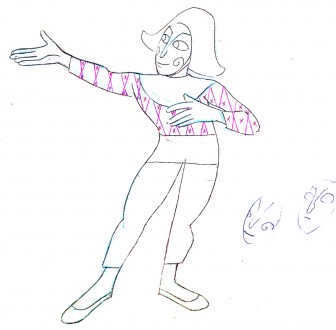
Animators:
- One is a brilliant mechanic of an artist who gets every pose every gesture just right. The movement of the character is perfectly flawless, the accents are always in the right place, the timing is perfect, and the weight captured is exact.
The character is developed but usually in a manipulated, studiously planned way. Usually, this animation, to me, is cold. Give the character a fake nose, and Laurence Olivier could be playing it.
(Art Babbitt, at the top of the triangle, is to me the model for this type of animator.)
(Babbitt dwng of Mime from Hubley’s Everybody Rides the Carousel)
.
Then there is the emotional animator. The poses, gestures, actions of the character are emotionally executed by the animator as if this were the only way it could come out. The drawings are often violent and immediate – pencils ripping through paper and dark blotchy artwork.
 This animator often puts emotion above mechanics, but (s)he digs to the depth of the part to find a real living thing. It isn’t always beautiful, but there’s a gem of a character on the screen. Like any living organism it’s unexpected and natural. Often this type animator works straight ahead (Does dwg#1 first, then #2,
This animator often puts emotion above mechanics, but (s)he digs to the depth of the part to find a real living thing. It isn’t always beautiful, but there’s a gem of a character on the screen. Like any living organism it’s unexpected and natural. Often this type animator works straight ahead (Does dwg#1 first, then #2,
(Grim Natwick, to me, is the prime example of this type.)
No, I’m not saying if you draw dirty, rough, violent drawings you’ll be a great animator. I’m speaking somewhat metaphorically – although the two examples I gave actually did draw that way. I’m sure Art Babbitt did one or two rough,
(Grim Natwick drawing from a Mountain Dew spot.)________violent drawings in his life, but
__________________________________________________his animation feels tight, controlled, yet beautiful. Grim also did one or two clean drawings in his time – I have one, as a matter of fact, but his animation is controlled by his feelings, accumulated knowledge of craft, and emotions. It all feels immediate, spur-of-the moment. It’s alive!
I’ve only ever watched animated films with this guide going in the back of my head. Mind you, also, I have enormous respect for both of these types; it’s just that I prefer the emotional type. More than wanting my characters to think, I want them to feel.
My temptation, here, is to give the obvious list of animators and where they fall in my model, but I think for now I won’t. CGI also fits into this mold, but it’s not a great picture. I’m curious to hear what others think of this model.
 - I don’t mean for this post to turn into a “praise Grim Natwick” nor a “put down Art Babbitt” statement. I hope it doesn’t read that way.
- I don’t mean for this post to turn into a “praise Grim Natwick” nor a “put down Art Babbitt” statement. I hope it doesn’t read that way.
As I’ve said in the past, I treasure the drawings I have that were done by Art. I study and love every frame of any piece he’s ever animated. I just have more fun, personally – and I underline that word, personally, reviewing Grim’s animation.
Marlon Brando wasn’t a better actor than Laurence Olivier. They just came at it from different angles, and my preference has always been the more natural side of the acting world.
 Back in the late thirties when the Group Theater was formed, these actors went to Russia to search out Stanislavsky, an acting teacher who preached at the bible of natural movement – getting in touch with your inner soul to project through the acting.
Back in the late thirties when the Group Theater was formed, these actors went to Russia to search out Stanislavsky, an acting teacher who preached at the bible of natural movement – getting in touch with your inner soul to project through the acting.
On Broadway, recently, was a revival of Awake and Sing. Clifford Odets was a member of the original Group Theater, and his plays reflected their “common man” attitude to theatrical productions. They weren’t trying to do spectacles or Royalty plays, they were trying to project the “average Joe” back from the stage. It changed theater, created Arthur Miller and a whole breed of acting styles. Compare, ex-Group Theater performer, John Garfield’s performances of the thirties with someone who was praised to the hilt back then, Paul Muni. Completely different acting styles – one natural and one overemotional and unrealistic.
The same was and is true of animators’ performances.
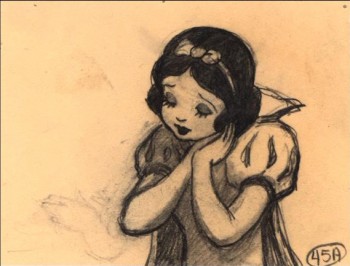 At Disney’s, these guys took their animation seriously. Some, such as Fred Moore and Norm Ferguson, thought they had it right and continued their own paths. Some looked into Stanislavsky and rejected it; others adopted it wholeheartedly. Still others, such as Grim Natwick, did it naturally and always had. Just as in the theater.
At Disney’s, these guys took their animation seriously. Some, such as Fred Moore and Norm Ferguson, thought they had it right and continued their own paths. Some looked into Stanislavsky and rejected it; others adopted it wholeheartedly. Still others, such as Grim Natwick, did it naturally and always had. Just as in the theater.
Next time you look at Fantasia, try just watching the acting styles. There’s nothing more Stanislavsky than Bill Tytla‘s scenes in Night On Bald Mountain, and there’s nothing less Stanislavsky than most of the animation in the Pastoral sequence.
Books &Commentary &Independent Animation 19 Jul 2009 07:32 am
Book of Kells
- Having seen The Secret of Kells yesterday, I felt it was time to take another look at The Book of Kells. It’s been a while for me, though the book has been sitting on my shelves for the past 35 years or so.
 The artwork in the film is luxurious (although the characters tend toward the big-eyed cute side), but no matter how daring the style could have been, it didn’t quite match the absolute daring and drive of the original illustrations.
The artwork in the film is luxurious (although the characters tend toward the big-eyed cute side), but no matter how daring the style could have been, it didn’t quite match the absolute daring and drive of the original illustrations.
The Book of Kells is a hand written – drawn is actually the more appropriate word – transcription of the new testament. It was done by monks who might have spent an entire lifetime illustrating one page. The purpose was to save a written transcription of the Christ story despite the invasions of the Norse pagans.
This is essentally the story of the film, though the Christ-story part is left out. There is an 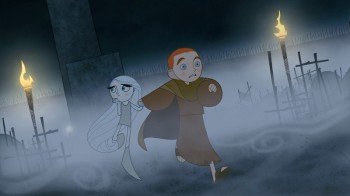 unusal mysticism within surrounding wooded areas in the film, but the mystical is left out of the Christian complex despite the fact that this is their primary mission.
unusal mysticism within surrounding wooded areas in the film, but the mystical is left out of the Christian complex despite the fact that this is their primary mission.
The most amazing part of the film is that it’s a telling of the story behind a work of Art. Of course, the monks didn’t think of it as art. To them it was just a telling of the Gospels. I’m not sure I can think of any other feature animated film that tries to relay the creation of an artwork.
I found the film beautiful, scene for scene, but felt there was, for me, no emotional connection. I might have preferred the film set in a slightly more realistic setting to separate the world of the gospels and spirituality from the real world. Others I spoke with didn’t have that reaction, so it’s no doubt my problem.
The film does feel, at times, a bit like Gennady Tarkovsky’s Samurai Jack (or, for that
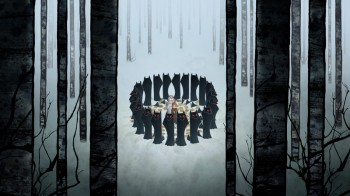 matter, Mr. Magoo’s Christmas Carol) and is undoubtedly a virtuoso performance of flat animation. It seems to mix traditional with Flash with CGI for the end product. Some CG scenes of waves washing on the shore were beautifully constructed. Scenes of the dark, heathen woods were also beautiful.
matter, Mr. Magoo’s Christmas Carol) and is undoubtedly a virtuoso performance of flat animation. It seems to mix traditional with Flash with CGI for the end product. Some CG scenes of waves washing on the shore were beautifully constructed. Scenes of the dark, heathen woods were also beautiful.
However, it’s all very heavy design all the time. In fact the design seems to resolve some of the conflicts that occur in the film. At least, I wasn’t able to quite get what happened several times, except that the climaxes were waved over the abstractions of some of the scenes and everything was taken care of. It did seem to work, in a not very physical way. I’m not sure how much our predecessors, in the animation industry, would have accepted it. Not quite as satisfying as actually being able to defeat the enemies (except in an allegorical way) though even the visualization of the enemy wasn’t quite physical enough for my taste – given that so much of their art went into the Book of Kells, itself.
The film, unlike most recent animated films (Miyazaki excluded) has a sense of depth that is quite comforting to see again. I’d recommend it wholeheartedly to anyone despite my few gripes.
My guess is that it will get a larger release this year. They’ve just gained a distributor and there is that Buena Vista logo at the head of the movie. Hopefully it’ll show up at Oscar time.
Now to some of those illustrations from The Book of Kells:

(Click any image to enlarge.)

Of course, the four Evangelists, who wrote the gospels,
are depicted throughout The Book of Kells.
A man, a lion, a calf and an eagle.
John, Luke, Mark and Matthew

The design is quite extraordinary and should have inspired
many a modern work of art.


The Evangelists, again.
Matthew and Mark.
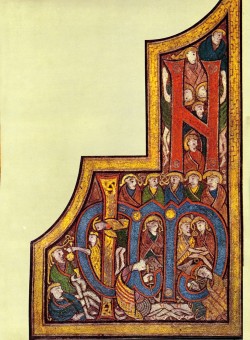
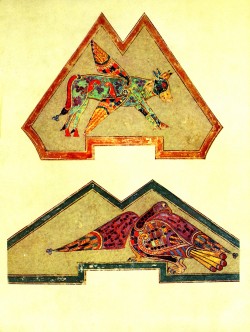
The book, for the most part, is a written manuscript of the Gospels.
Plenty of little and beautiful iconic figures wrap around and within the
hand-drawn type.
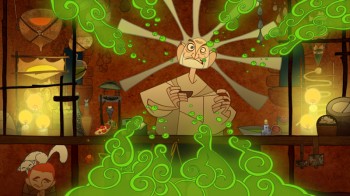
How could I resist adding this still from the film?
Commentary &Daily post 07 Jul 2009 07:23 am
Alice apoplexy
 - The internet has been overrun with images from Tim Burton’s Alice in Wonderland, now in production. Lots of Victorian inspired, detailed photos of stars dressed like characters from the film. I’ve pulled a few of them and am posting them here.
- The internet has been overrun with images from Tim Burton’s Alice in Wonderland, now in production. Lots of Victorian inspired, detailed photos of stars dressed like characters from the film. I’ve pulled a few of them and am posting them here.
Alice has been a problem project which so many studios, artists and filmmakers have attempted to tackle. None have been very successful. The 1933 Norman McLeod version was one of the first and one of the better versions. Edward Everett Horton, Sterling Holloway and Richard Arlen give Charlotte Henry enormous support in this interesting albeit very stagey version.
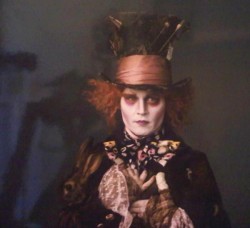 Disney’s animated feature is probably one of the best known of the films. It’s good in its own rite, but hardly captures the imagination of the Lewis Carroll book or the Tenniel illustrations.
Disney’s animated feature is probably one of the best known of the films. It’s good in its own rite, but hardly captures the imagination of the Lewis Carroll book or the Tenniel illustrations.
Lou Bunin‘s version is very studied and lacking in much of the drama and whimsy of the story. As a matter of fact, that’s the problem with most of the versions. The story is somewhat like Candide in that it is picaresque in its adventures and becomes hard to dramatize. Burton’s an accomplished filmmaker, but his recent films have begun to look alike. Sweeney Todd doesn’t have the depth that it might have. A lot went into trying to captures Sondheim’s brilliant score, but that came at the expense of the story, itself, which became too much of a surface event.
Regardless, the pictures have had their effect in that it’s made me curious to see what he’ll do with the book.
Here’s a short commentary by Wolcott Gibbs I found in the July 16, 1938 issue of The New Yorker magazine:
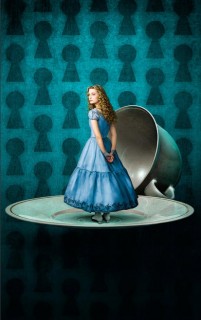 We are one Walt Disney’s warmest admirers, but we can’t approve of his notion of making an animated cartoon out of “Alice in Wonderland,” Mr. Disney says that if he ever does make the picture, he proposes to follow the Tenniel illustrations, at least in spirit.
We are one Walt Disney’s warmest admirers, but we can’t approve of his notion of making an animated cartoon out of “Alice in Wonderland,” Mr. Disney says that if he ever does make the picture, he proposes to follow the Tenniel illustrations, at least in spirit.
We don’t think this is going to work. Tenniel drew with a fine line, in enormous detail; the movies call for simple, conventionalized figures. The result would be that; Alice would look like Snow White (and probably talk like an elocution school) and a lot of nice, middle-aged people would get apoplexy.
Even harder than reconciling the styles of drawing, we think, would be the problem of adjusting Lewis Carroll’s humor to an audience of a hundred million people, many of whom consider Joe E. Brown the nation’s foremost comic. We don’t like to think of the things that would have to be done to make Alice a box-office success. We don’t want to see the Frog-Footman swallow a cake of soap and hiccough bubbles, or to hear “Jabberwocky” set to swing.
As a matter of fact, we never want to see Alice move or talk at all, and we don’t really believe that Mr. Disney, a modest man, wants to make her, either.
Articles on Animation &Commentary 05 Jul 2009 08:37 am
Violence & Joe Barbera
Having posted some photos yesterday for July 4th, let me turn to something animated.
- After seeing Ice Age 3 (or half of it, I had to leave), I began to think about children’s films. The pendulum seems to have swung again. There was a time when Variety and The Hollywood Reporter were filled with articles pro and con cartoon violence. (Violence can be ripping the hair off an animal’s chest or attacking dinosaurs.) Once the networks stopped airing their Saturday morning blocs of programming, no one seems to have taken much notice.
This is an article by Joe Barbera about why he should be allowed to smash Tom in the teeth with a golf ball. (It’s funny!)
I’m posting this as a reminder that there ARE consequences to what we show and tell our children.

Pick a cartoon gag. Any gag. Remember the one when Tom hit a golf ball off Jerry’s ear, only to have it ricochet off a tree and come back dead solid perfect off Tom’s teeth? Or how about the one in which the bad guy drops an anvil off the head of Huckleberry Hound, who shakes it off and wobbles away. Sound familiar? Remember when you were a kid, how you laughed at those? Take my word, you did. But those gags and others like them are only memories now because you won’t see them on cartoons produced today.
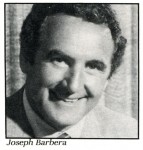 Today’s cartoon shows, believe it or not, are not allowed to contain gags of this type. Why, you can’t even throw a cream pie at a character. Explain that to Soupy Sales, who made it into a comic art form that gave us all a big laugh. These visual gags are considered too violent; too extreme; too negative an influence on today’s cartoon watcher.
Today’s cartoon shows, believe it or not, are not allowed to contain gags of this type. Why, you can’t even throw a cream pie at a character. Explain that to Soupy Sales, who made it into a comic art form that gave us all a big laugh. These visual gags are considered too violent; too extreme; too negative an influence on today’s cartoon watcher.
For that you can blame, or thank, depending on your point of view, broadcasters, who have been effectively lobbied by small but exceptionally effective pressure groups. I’m sure they have all the best intentions in the world, but what they may not realize is that they are destroying the cartoon as we know it and diminishing the creativity that has made animation a successful, entertaining medium. Now cartoons are produced using what I call “compromise humor.”
It started a decade, ago when a concerned group of parents and teachers complained that cartoons were to blame for society’s ills. Television personnel took heed of the outcry of a vocal minority and put their collective foot down as to what is and what is not acceptable in today’s cartoon.
Now, don’t get me wrong. I understand everyone’s concern. But I don’t think they fully realize the consequences of these limitations. By placing the same restraints on the animation producers, the material is being flattened out. In other words, the creativity in what we can do is limited. Because the same “rules” apply to us all, there comes a feeling of sameness in all new cartoons produced, which television critics have noted this season. The little touches of style and timing that would separate each cartoon series and production house are not as distinctive as they once were, and that is a shame.
If the same set of rules were around 30 years ago, Hanna-Barbera would have never produced Huckleberry Hound, Yogi Bear, Quick Draw McGraw and the Flintstones as we know them today. What made those shows and others successful was exaggeration — the hallmark of animation. Cartoons are an exaggeration of real life. Cartoons are fantasy and fun. Cartoons are not real life. Cartoons are not the solution to the world’s problems, and it is my belief they should not be forced to pretend they are.
The cartoon is a visual medium, expressing universal humor that reaches all children of every nationality without the need for words. I still don’t know if adults realize that children have different standards as to what is funny and what isn’t.
Again, don’t get me wrong. There are still boundaries of good taste we should adhere to. Hanna-Barbera will never do a cartoon promoting drugs, for example. In fact, we produced a primetime special ABC aired this season called “The Flint-stone Kids, Just Say No.” The White House commended the special, which is now available on home video, with a portion of the proceeds to benefit the Just Say No campaign.
Obviously cartoons should not take the place of the personal guidance of parents and teachers. Situations that are real and factual are the job of schools, mom and dad, grandma and grandpa.
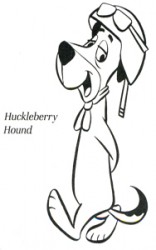 Let’s face it. Kids are not watching cartoons for educational input: They are watching to be entertained. You can’t have a cat chasing a mouse stop to teach it about American history. It doesn’t work. We tried it. We’ve worked with consultants and pressure groups but the kids were bored and turned us off.
Let’s face it. Kids are not watching cartoons for educational input: They are watching to be entertained. You can’t have a cat chasing a mouse stop to teach it about American history. It doesn’t work. We tried it. We’ve worked with consultants and pressure groups but the kids were bored and turned us off.
If children don’t find something that entertains them on television, they pop a cassette of classic cartoons into the VCR and watch them instead.
While my partner Bill Hanna and I are on the road promoting the homevideo tapes we sell, we hear from hundreds of parents who make a special point of telling us how much they love our shows, and trust them. Many parents have confided to me that they are concerned about what their children watch, but think it’s completely safe for their children to watch a Han-na-Barbera show. They confess that they like to watch our shows with their children, but don’t find the cartoons of today very funny. They want to know when we are going to bring our good old ones back.
I think the kids who watch cartoons agree with me. ABC brought back Bugs Bunny and Tweety cartoons to Saturday morning this season. These are not new cartoons. Most of them were made more than 40 years ago, with good old exaggerated gags. The fact that the show is doing well in the ratings suggests that children like these cartoons. But if those cartoons were being produced under today’s strict standards, the same type of humor wouldn’t be there, and I guarantee the ratings wouldn’t be either.
Cartoons are supposed to start where reality ends. If you want to put three heads on a character, you do it. You shouldn’t have to stop and think about who would like it and who would find it distasteful. Something like that works better visually than it will ever sound in words.
We did a successful cartoon series in 1964 called “Jonny Quest.” It was the forerunner to Indiana Jones. It was a family action-adventure series with human characters, not animal characters with human traits. It featured Jonny Quest, an 11-year-old boy, who helped his father battle Dr. Zin and others with futuristic gadgets, lasers and submarines. Now we don’t expect 11-year-old boys to find their neighborhood submarine and leave home, but our watchdogs act as if those things were really going to happen. With the restrictions that inhibit imagination, the Indiana Jones-type entertainment would not be nearly as successful. In fact, if today’s standards were around back in the Golden Days of Television, I seriously doubt if Laurel and Hardy and Buster Keaton would have made it.
Children are entitled to their own entertainment. Today’s children exhibit signs of stress and pressures at younger ages. I would rather they found a release valve by watching cartoons purely for entertainment than be exposed to the sex and violence of primetime programs and the news.
So what is the answer? Let Hanna-Barbera and the other animation producers govern themselves. Let Hanna-Barbera take the experience of seven Oscars and eight Emmys and do what we do best. We know what makes a cartoon funny. We know the boundaries of good taste. Please don’t let “compromise humor” become the standard that governs creativity.
To end this, let me give you the lyrics of a great song by Stephen Sondheim from Into the Woods:
Nothing’s all black, but then nothing’s all white
How do you say it will all be all right
When you know that it might not be true?
What do you do?
Careful the things you say
Children will listen
Careful the things you do
Children will see and learn
Children may not obey, but children will listen
Children will look to you for which way to turn
Co learn what to be
Careful before you say “Listen to me”
Children will listen
Careful the wish you make
Wishes are children
Careful the path they take
Wishes come true, not free
Careful the spell you cast
Not just on children
Sometimes the spell may last
Past what you can see
And turn against you
Careful the tale you tell
That is the spell
Children will listen
How can you say to a child who’s in flight
“Don’t slip away and I won’t hold so tight”
What can you say that no matter how slight won’t be misunderstood
What do you leave to your child when you’re dead?
Only whatever you put in it’s head
Things that your mother and father had said
Which were left to them too
Careful what you say
Children will listen
Careful you do it too
Children will see
And learn, oh guide them that step away
Children will glisten
Tample with what is true
And children will turn
If just to be free
Careful before you say
“Listen to me”
Commentary 03 Jul 2009 09:04 am
Animated sounds
- In the past there were a limited number of animated studios. Disney, Warners, MGM, Fleischer, Paramount, Lantz, Terrytoons, Columbia/UPA. The interesting thing about every one of those studios is that just by listening to a snippet of any soundtrack from any of the films, you could tell which studio had produced the short.
- The rich, symphonic scores and orchestrations of the Disney films by Frank Churchill, Leigh Harline and Oliver Wallace among others.
- The WB films had the strong Carl Stalling style.
 - There was the richer, yet, equally strong Scott Bradley style for MGM. Who used more original and modern music for his scores.
- There was the richer, yet, equally strong Scott Bradley style for MGM. Who used more original and modern music for his scores.
- That oddly orchestrated sound for Fleischer/Paramount kept changing in the same direction whether under the direction of Sammy Timberg or Win Sharples.
- Terrytoons had to have had the oddest sound under Phil Scheib. Even the Terry sound effx felt as though they were recorded under water and had a peculiarly original sound. It was an acquired taste, but I loved it.
- Clarence Wheeler helped Walter Lantz bring a large number of jazz scores______Tex Avery & Scott Bradley (seated)
to his forties films and found an original
formula for the shorts he scrored in the fifties. Again these Universal cartoons sounded different from the other studios’ tracks.
- On the completely other end of the spectrum were UPA’s chamber groups done in that style for the cost factor, but the composers were all artists and the scores were well ahead of their time, musically. David Raksin, George Bruns, and Gail Kubik among others writing these scores. Nothing else sounded like it.
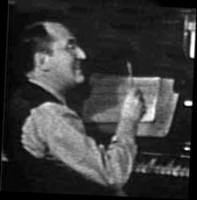 There was no doubt the Terrytoon’s scores by Phil Scheib (seen left) weren’t for a Disney project, and the sometimes-too-rich Disney scores weren’t for the MGM films (even the Harman-Ising films emulating Disney sounded different.) The MGM scores were different stylistically from the Stalling WB scores – even though the visuals were done by many of the same people travelling across town.
There was no doubt the Terrytoon’s scores by Phil Scheib (seen left) weren’t for a Disney project, and the sometimes-too-rich Disney scores weren’t for the MGM films (even the Harman-Ising films emulating Disney sounded different.) The MGM scores were different stylistically from the Stalling WB scores – even though the visuals were done by many of the same people travelling across town.
In short, I think these scores almost served as a trademark for the individual studios. This is something I don’t see (hear) in today’s films. Most of the composers are independent artists tavelling from studio to studio. John Powell or Randy Newman, or Hans Zimmer bring their individual sounds to whichever studio’s films they score. (Alan Menken and Michael Giacchino seem to be the nearest thing to house composers, the former having done a number of Disney scores and the latter only music for Pixar films. Neither has moved to any other studios, as yet.)
Since many of the artists seem also to be traveling back and forth between studios, the end result is a sort of homogenization of the films. Many of the CG films look like others of the CG films. The differences are certainly not in the soundtracks, although the Dreamworks films have more of a preponderance for screaming rather than talking. This trait is also recently showing up in the Pixar films.
Hans Zimmer has written:
Disney: The Lion King
Dreamworks: Madagascar 1 & 2, Kung Fu Panda, Shark Tale, Spirit, Prince of Egypt,
Steven Schwartz wrote lyrics and/or songs for:
Disney: Pocahontas, Hunchback of Notre Dame, Enchanted
Dreamworks: The Prince of Egypt
Randy Newman:
Disney/Pixar: Toy Story 1,2&3, The Frog Princess, Monsters Inc, Cars, A Bugs Life
Henry Selick: James and the Giant Peach
John Powell has scored:
Disney: Bolt
Dreamworks: Shrek, Kung Fu Panda, The Road to Eldorado
Blue Sky: Robots, Horton Hears a Who, Ice Age 1,2,3
Aardman: Chicken Run
Universal: Happy Feet
me: Goodnight Moon (I was first)
Commentary 25 Jun 2009 08:14 am
Nijinsky – “He’s ALIVE !”
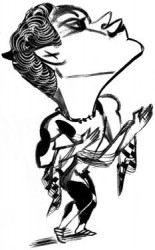 - The New Yorker magazine, this week, has a short article by Joan Acocella about some YouTube videos that have appeared recently showing Nijinski dancing. They’re all short clips (10-15 secs) in, what looks like, early film footage as Nijinsky goes through bits of his most famous dances from 1910-1912.
- The New Yorker magazine, this week, has a short article by Joan Acocella about some YouTube videos that have appeared recently showing Nijinski dancing. They’re all short clips (10-15 secs) in, what looks like, early film footage as Nijinsky goes through bits of his most famous dances from 1910-1912.
The only problem, of course, is that Nijinsky was never filmed dancing. These pieces are animated bits by Christian Comte, a French animator working out of Cannes. He’s taken the famed series of stills of the great dancer and maneuvered them in his computer to make it look as though they are actual moving. I watched them all and only one move looks artificial, as though Nijinsky were on wires as he glides up and over.
In Acocella’s interview with Comte, he describes his work:
- Comte acknowledged his authorship. “These films are animations of photographs, achieved thanks to a process that I invented,†he said. “I work as an alchemist in animated cinema.†He uses still photographs and, by employing a computer to alter them—tilt a head, move an arm—fills in the gaps between successive shots. That’s why his “Faun†footage is so much longer than his other footage. He had all those de Meyer stills. This is basically no different from the way Steven Spielberg got the dinosaurs to run around the jungle in “Jurassic Park.â€
Comte insists that he is not trying to pass off his Nijinsky clips as authentic films. His YouTube profile page opens with a statement that it is a “mad legend†that any film of Nijinsky dancing survives. Yet he goes on to call his postings “film fragments.†All of them display the date of each ballet’s première—1910, 1911, or 1912—but they do not explain that this is not also the date of the video.
Here is one extended YouTube piece that I believe shows some tests and dailies strung together. All of the others are cut into shorter snippets and black-outs, hence feel more like actual fragments. When strung together like this, you can feel the manipulation.
We’ve undoubtedly entered a new era of artificiality. Animation has moved closer to reality (except for the inexperience of the animators, themselves.) The first 20 mins of Wall-E set a tone of reality that matches the effects in Dark Knight. The mix of live action footage with the animation made it feel more real. (Of course the last 60-70 mins of the film felt artificially devised and spoiled those opening 20.)
It’s hard to go back to Snow White anymore now that the apple has been tasted.
Commentary 13 Jun 2009 07:17 am
Who’s watching?
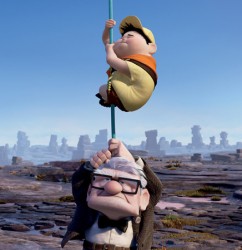 - About a year ago, a film of mine was accepted by a film festival. The festival contact called asking what age group te film was made for. I’ve often been asked this question and have always answered it uncomfortably. At times I’ll answer for the 6-12 year old age group; at other times I’ll just say family audiences – the same as The Lion King. Lately, I’ve been saying it was made for me – I don’t give them my age group.
- About a year ago, a film of mine was accepted by a film festival. The festival contact called asking what age group te film was made for. I’ve often been asked this question and have always answered it uncomfortably. At times I’ll answer for the 6-12 year old age group; at other times I’ll just say family audiences – the same as The Lion King. Lately, I’ve been saying it was made for me – I don’t give them my age group.
The question has been a sore spot for me my whole career. I don’t deny that my films are designed for children. That means I try to keep the film somewhat PC, but then I’d do the same if the film were made for 60 year olds. I’m not into making films that are designed to be offensive – no farts, no cigarettes, no foul-mouthed characters. I don’t see the point of it. It’s not because I’m trying to be a good role model for children; it’s because I don’t think films need these things.
Citizen Kane and Vertigo couldn’t be more adult, yet there’s not much offensive on the screen. Why bother, unless you’re trying to make a point?
I thought of this problem, for me, with a recent post on Jenny Lerew‘s Blackwing Diaries. She responds to a letter to the editor at the NYTimes regarding the review of Up by Manohla Dargis.
Jenny’s right; the film is not just for kids. Regardless of whether you like dislike or have problems with the film, it’s not really designed for a targeted audience other than the filmmakers, themselves. The problem is that it’s an animated film, and the notion still exists in the general public that all animated films are specifically designed for children.
 This, however, might cause some problems. I did a film called Whitewash back in 1994. (It plays on HBO Family all month during July:
This, however, might cause some problems. I did a film called Whitewash back in 1994. (It plays on HBO Family all month during July:
7/ 5 4:40 pm, 7/ 6 5:25 am,
7/10 3:05 pm, 7/15 3:55 pm,
7/18 3:30 pm, 7/21 8:30 pm,
7/27 3:45 pm – all EST, adjust for your time zone.)
This was a tough one. It was a docudrama done for HBO which responded to a couple of actual events.
There were two black children, brother & sister, in the Bronx who were attacked by a white street gang. They were spray-painted white and sent off, humiliated. After a bit of research I found several other variants on the same news story. A Puerto Rican child, in the same neighborhood, also spray-painted white. There was more recently a Korean child spray-painted black by a black gang in Brooklyn.
What’s the audience for this? I treated it with the greatest sensitivity I could, hired an important African-American playwright, Ntozake Shange, to write the initial script based on
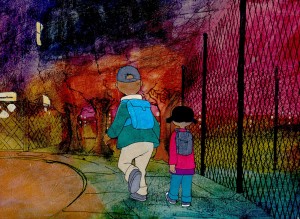 my treatment. I added lots of improvised dialgue by children. I designed it, with the help of the brilliant Bridget Thorne, as a dirty-street colored film after variants of hip-hop art. I wanted my beloved New York City to look dirty. It was.
my treatment. I added lots of improvised dialgue by children. I designed it, with the help of the brilliant Bridget Thorne, as a dirty-street colored film after variants of hip-hop art. I wanted my beloved New York City to look dirty. It was.
I underplayed the actual attack showing no real physical violence. The one person in my studio who animated in the most Disney-like tradition was cast by me to animate the attack. I didn’t want it to be or look real, and I didn’t mind that it stood out from the rest of the movie.
Yet,when the film played at a children’s program in Ottawa – lots of cute cartoons and mine – a father three minutes into the movie grabbed his 3/4 year old child and raced from the theater. Bravo! I was pleased to see that one father acted responsibly. Yet, it’s often bothered me that that parent had to make the decision in the middle of such a program, advertised as children’s films. The film won a number of big awards – the Humanitas prize for best screenplay for children as well as the Crystal Heart Award at the Heartland Film Festival. Both are family oriented Christian organizations that take responsible filmmaking seriously.
However, after the Ottawa experience, I chose to keep the film out of festivals when I thought the same might happen. I’ve shown it at retrospectives of mine and at adult film festivals (it’s been very successful), but I won’t put parents in harm’s way again. It’s not fair. 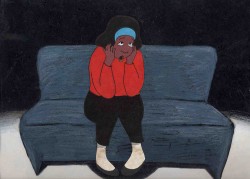
Another film of mine, Champagne, tells the story (in documentary style) of a child who was raised in a convent because her mother had committed murder and was incarcerated. The film has one short violent scene. This has not stopped me from submitting it to any festival that wants it. It’s a positive, hopeful and uplifting short, and I have no compunction in showing it to anyone – child or adult.
I guess, in the end, I have to say that filmmakers HAVE to make the best film they can (even if it includes flatulence) but they should also have a conscience about who the films are made for. The film has to be honest and clear, but it also has to live in our society.
Commentary &Daily post 06 Jun 2009 08:20 am
Spare Change
 - Having just posted lots of frame grabs from Bruno Bozzetto’s marvelous film, Allegro Non Troppo, I should have linked to his website. You can find there a page devoted specifically to this feature, as well as to his other two animated features: West and Soda and The VIP: My Brother Superman.
- Having just posted lots of frame grabs from Bruno Bozzetto’s marvelous film, Allegro Non Troppo, I should have linked to his website. You can find there a page devoted specifically to this feature, as well as to his other two animated features: West and Soda and The VIP: My Brother Superman.
You can also find there many hilarious Flash films that Bruno has done. This is some of the best use of Flash that I’ve seen – all for a great laugh. If you’re looking for on-line entertainment – this is it.
- Jeremiah Dickey (who has assisted Emily Hubley on many of her hits) sent this note:
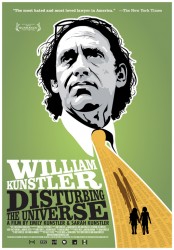 Salutations friends & colleagues in the NYC area,
Salutations friends & colleagues in the NYC area,
Two really superb documentaries for which Emily Hubley & I created animation last year are making their official NY premieres at the Brooklyn Academy of Music this month – come check them out if you can.
William Kunstler: Disturbing The Universe is a film about the life of the radical lawyer, made by his amazing daughters Sarah and Emily Kunstler. Part of BAMcinemaFEST, it will be screening on Saturday June 20th at 12:30pm, followed by a Q&A with the filmmakers (moderated by DemocracyNOW!’s Amy Goodman).
It will also be screened outdoors the following Thursday June 25th at 9pm in the parking lot across the street from BAM – links to tickets below.
_____6/20 _____6/25
What’s On Your Plate?, directed by Catherine Gund, daughter Sadie Hope-Gund & her friend Safiyah Riddle, follows the 11-year olds as they learn about the politics of food and its various impacts on urban sustainability, among other things. I should add that this film is also alot of fun. It will be screening for FREE in Fort Greene Park Saturday June 27th at 9pm, and screening again Tues July 2nd at 6pm as part of BAM’s Afro-Punk Film Fest.
Hope this finds everyone well -
cheers
Jeremiah
- Nina Paley sends the following message:
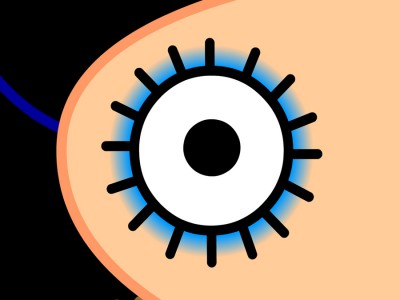 Dear friend of “Sita Sings the Blues,”
Dear friend of “Sita Sings the Blues,”
The Sita Sings the Blues Merchandise Empire is finally live and open
for business: http://www.sitasingstheblues.com/store
(redirects to http://questioncopyright.com/sita.html )
At last we have DVDs and T-shirts for sale. Thanks for your support –
I won’t spam you again!
Love,
–Nina
From Patrick Smith:
 “ANIMATION FROM HELL!”
“ANIMATION FROM HELL!”I’m curating a program for MOCCA Arts Festival this year called “Animation From HELL.” It’s a program of dark and twisted animation that will scare the fluffy bunnies out of any animation fan. This collection of disturbing shorts, past and present, has been hand picked by Satan himself.
Sunday, June 7, 2009
5:00pm – 6:00pm
at the Armory
68 Lexington Avenue, between 25th and 26th Streets
New York, NY
Commentary &Daily post 02 Jun 2009 08:25 am
MOMA and other shorts
Howard Weinberg, President of the New York Film/Video Council, will introduce a series of short films at MOMA on June 3 at 7pm. The films will screen again on June 4 at 4pm.
The Museum offers this bit of information:
- “Cosponsored with the New York Film/Video Council, MoMA’s annual showcase of recent narrative, documentary, animated, and experimental short films provides a glimpse into cinema’s future. Most short films are produced by young filmmakers at the start of their careers; at their best, these works are characterized by youthful vigor and a daring willingness to break with cinematic convention. The results can be funny, romantic, instructive, otherworldly, and insightful, and they frequently serve as bellwethers of future developments in the art of filmmaking.”
The program includes:
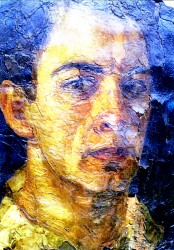 The Glass Trap (2008) Poland – Pawel Ferdek 15min.
The Glass Trap (2008) Poland – Pawel Ferdek 15min.The Portrait (2008) USA – Irra Verbitsky 4min.
Steel Homes (2008) Scotland – Eva Weber 10min.
Ten (2008) France – Bif 7 min.
Second Hand Pepe (2007) USA/Haiti/Can – Hanna Rose
______Shell, Vanessa Bertozzi 24min.
Left Behind (2008) Germany – Andreas Graefenstein, Fabian Daub 13min.
Eclipse (2007) Ind/Aus/New Z’land – Mark Lapwood 9 m
Lies (2008) Sweden – Jonas Odell 13 min.
Photograph of Jesus (2008) Grt Brit – Laurie Hill 7 min.
I’ve highlighted the one film because it’s the work of NY animator/artist, Irra Verbitsky (pictured right). Hopefully, a large audience will attend to cheer her film on.
I might take exception with MOMA’s statement that “Most short films are produced by young filmmakers at the start of their careers.” This somehow debases the work of most animation Independents. We can’t afford, for the most part, to do features. Shorts are expensive as well, but making them is obviously more manageable. Perhaps the same isn’t true of live action filmmakers. Perhaps once they’ve put their foot into the short film exercise, they can jump into producing feature films. Or maybe they give up.
Regardless, there are plenty of us out there making short films, animated, doc or live. We don’t need to feel diminished by an organization like MOMA that, I know, is supportive. Just bad copywriting.
- I must say that I enjoyed Mike Barrier‘s review of Up (in fact, I waited for it.) My only spark of contention is that I’m not a fan of Monsters, Inc. and he is. Regardless, he has a lot to say – even if you were a fan of the film – and is worth the read.
Over the years, as a film maker who has gotten a lot of very positive reviews, I’ve noticed that general film reviewers look at animated films in a different way than they do 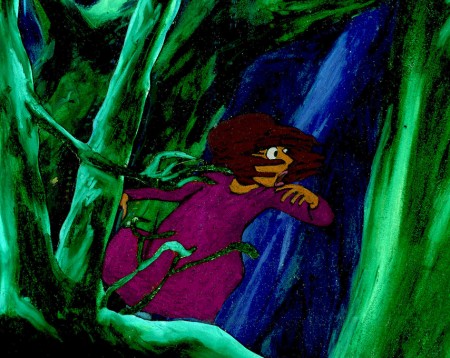 live action films. Animation gets a pass on lots of faults and is not treated as harshly. A film like Up gets praised to the hilt and generally good critics ignore significant problems that stare them in the face.
live action films. Animation gets a pass on lots of faults and is not treated as harshly. A film like Up gets praised to the hilt and generally good critics ignore significant problems that stare them in the face.
After I’d finished The Red Shoes, I thought that the story was just not well told. The film seem too compressed, and I felt I needed another 15 minutes to get it out logically and properly. No, the reviewers were all aglow, yet I know that if I had done the exact same film in live action, I would have been castigated for my sins. Or, at least, that’s how I felt.
Now, I think the same can be said for the last two Pixar efforts. They’ve been blessed by critics who miss the trees and the forest for a pretty drawing of the same.
Coraline, the theatrical production, has just opened in NYC ath the Lucille Lortel (a beautiful little gem of a theater in the West Village.)
The review in the NYTimes can be found here.
Commentary 01 Jun 2009 07:31 am
Up
Everyone’s giving a review of Up, so how can I resist after promising as much last week.
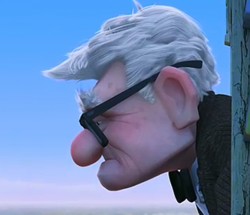 - I have to hand it to Pete Docter and Pixar; UP is a very good film. However, there are challenges for this viewer.
- I have to hand it to Pete Docter and Pixar; UP is a very good film. However, there are challenges for this viewer.
The first ten minutes are nicely flawless and set up the story well. Then, after Carl is widowed, the film settles down to earth and gets a bit mundane. Once Carl goes to court, the film shifts, turning into a cartoon and losing its lyricism increasingly as the film moves on. More and more, the imaginiative and unlikely ideas are thrown at us, and the story becomes less and less believable.
There’s a nice, expedient and acceptable way for Docter to cut short the flight and get them to their South American desitination. It’s smart, but it left a big, “Huh?” for me before I moved on. That’s when the dogs enter wearing their jokey voice collars. I wonder if it might have been better for them to keep the dogs without voices. That would probably have offered fewer gags but a bit more logic.
Michael Giacchino‘s score is excellent. The main themes sound a bit like music from a Doris Day film. Light, bubbly and “50s”. It brings the airiness the film tries hard to maintain.
There are several refernces to King Kong (the 1933 version). It occurs when they’re entering a terrain that seems a bit remniscent of the native village in Kong. Lots of repetitive drums right out of Max Steiner’s original score. The most obvious reference, of course, is those dogs in bi-planes trying to shoot down Russell. A couple of the jungle terrains also seem to be pulled from the earlier film.
But then, the film includes dozens of references to other live action films: the opening seems right out of Citizen Kane, the villain is named Charles Muntz (sounds like Mintz) and looks like Kirk Douglas, Carl looks like Spencer Tracey. There are many more, but I’m not sure if they’re there for any purpose other than “fun”.
There’s some animation in the film that’s quite fine , but there’s also some not-so-good animation there. Lots of slipping and sliding in walk cycles; lots of weightless characters (an old cgi bugaboo.) However, it’s miles above most of what I’ve recently seen and does give me a bit of hope.
Up‘s credibililty, for me, roams far from reality with a number of points including: a super humongous zeppelin (where do they get the petrol to run this thing?), talking voiceboxes on the dog collars (not only is the villain a great adventurer, he’s also a brilliant inventor able to read dog-thoughts and build this eccentric machinery in the wild), dogs flying bi-planes with dart-shooting machine guns, and many other bits of business just turn the film into a not-very-believable cartoon.
Of course, all this is a byproduct of the principal idea – a house being lifted by hundreds of balloons. It’s certainly impossible, but we all came into the theater knowing this to be a basic premise, and we agreed to accept it before sitting down. However, I’m not sure we were buying into a lot of other cartoony ideas after sitting through that excellent opening that ultimately seems to be from a different film. It’s as though Bambi had Bugs Bunny as a friend, not Thumper, and the film kept trying to squeeze them together for us.
I’d hoped to accept the entire premise as a conceptual metaphor. Though, I don’t think Docter, in his unspooling of the story, allows us to take this approach to the imaginative but cartoony ideas, so I had to ride with it at face value.
Perhaps this is all irrelevant to most viewers; the film is quite enjoyable while watching it. I did find myself stepping in and out of the story as it progressed, thanks to lapses in credible moments. I also found the film a bit tiresome at about the 2/3 point. Like Wall-E when they’re chasing around in space, inside and outside the spaceship, this film has a dangerous chase inside and outside a zeppelin, on and off the balloon house. They came to the precipice at least four times too many and escaped every time.
I’m glad for what they gave me in this film, but I guess I’m the curmudgeon who hopes the “Action” scenes will be a tad more plausible in screen stories. And I guess I also wish for a little less “Action” in those films. All that running about over and over again get tedious.
But make no mistake, I do think UP is a very good film . . . just not the great one it might have been.
By the way, you have to check out Lou Romano‘s site which is filled with brilliant pre-production art for this film.

